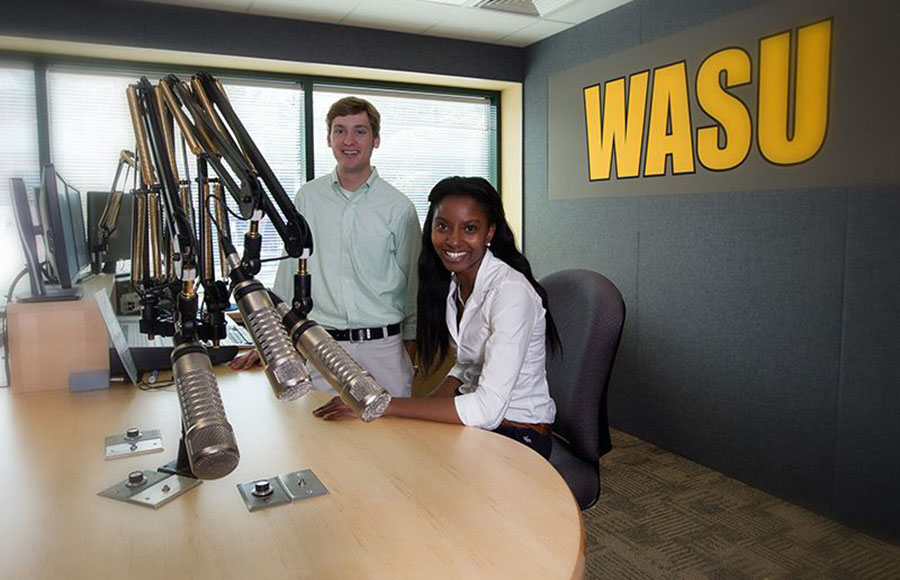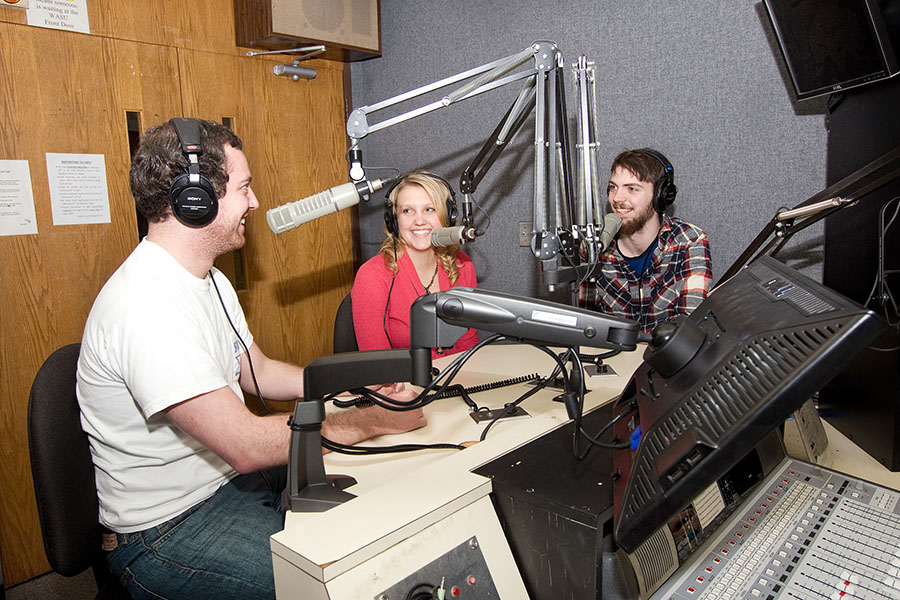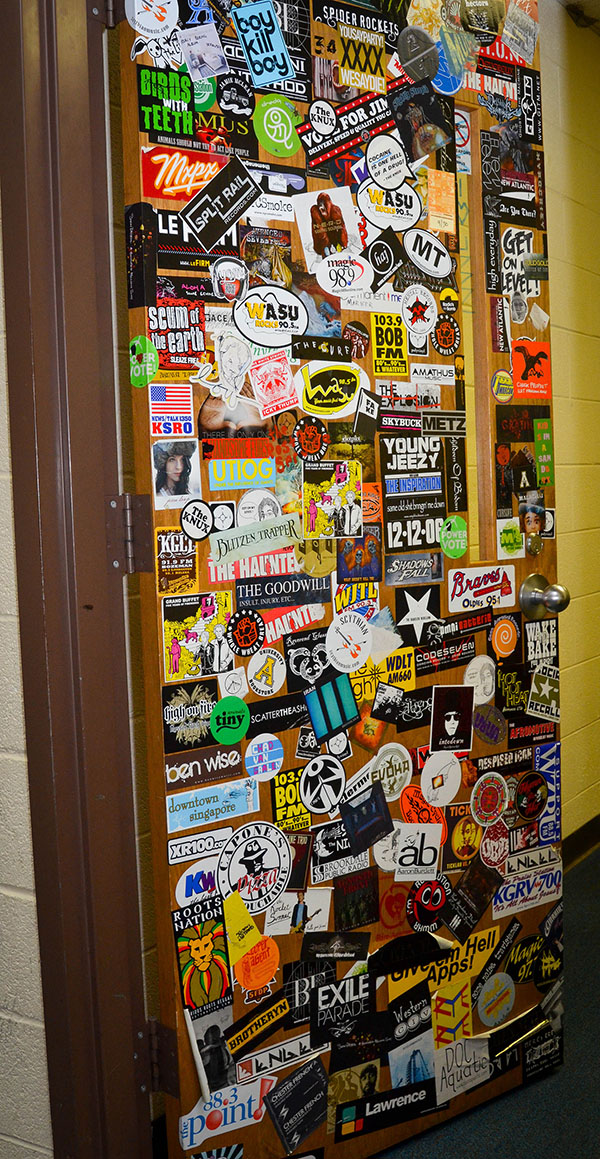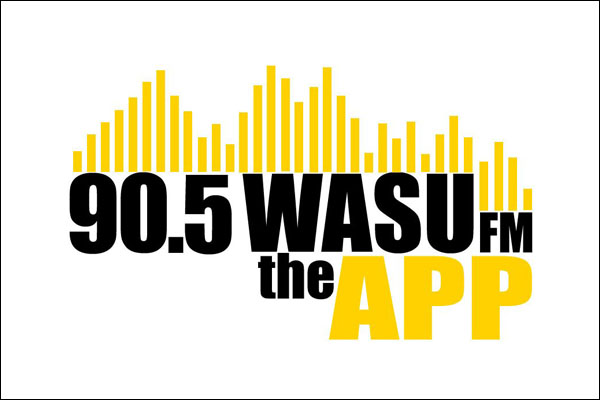The only thing behind the door marked "340 RADIO CONTROL" on the third floor of Wey Hall are the skeletal remains of a college radio station studio. The room has seen better days. Not long ago it was an energetic hub for students to nurture their ambitions of something big—bigger than the tiny cubical of a room from which they broadcasted.
The rest of the rooms are mostly empty now, except for 35 years worth of rock band decals and stickers in every shape and color layering the doors, a sign that it's not empty of character or memories.
But radio isn't dead; it's alive and well. And 90.5 WASU-FM, Appalachian State University's student-run radio station, hasn't gone anywhere ... at least not far.
On June 20, across the street in a studio at least three times as large as Wey Hall's, WASU launched a new era of radio as it broadcast for the first time from the Wayne and Karen Sumner Studio in the new 18,000 square-foot George G. Beasley Media Complex. Beginning fall 2013, new and returning broadcast students will be among the first in the media complex, which houses broadcast studios, classrooms, labs and offices for faculty members.
A generous gift from Appalachian alumnus George G. Beasley of Naples, Fla., along with state funds and other private donations, have made the media complex a reality.
"George Beasley well knows how a college education can change a person's life. His truly life transforming gift will enable many students to pursue their dreams of earning college degrees and entering careers in broadcasting," Chancellor Kenneth E. Peacock said.
"We were professional before, but we're moving up to a whole new standard now," said Christian Morgan, a senior electronic media broadcasting major. "When students come into the broadcasting program, a lot of them have never seen an actual radio or TV station. The fact that the building imitates a professional station gives the students an eye-opening experience."
From cramped quarters to spacious new digs
The radio station began in Chappell Wilson Hall, where it first went on the air in 1972. When the station moved to Wey Hall six years later, it had to form around an existing space. The new media complex, however, is designed for a radio station, said Dan "Vallie" Hill, an industry professional who also oversees WASU as a practitioner in residence.
"The students were pretty cramped over there," Vallie said, about the Wey Hall location. "There were some disadvantages, but we made it work."
That make-it-work attitude earned the station a "College Radio Woodie Award" in 2012 and the "Shoulda Coulda Woodie Award" in 2011, both from mtvU. And in early July, the New York Festivals International Radio Programs & Promos Competition named WASU as a finalist in The World's Best Radio Programs & Promos for 2013. The competition honors radio programming and promotions in all lengths and formats.
The move to the new building hasn't changed the listener's experience, Vallie said. Besides the addition of a replica on-air practice studio, the most notable change is that students and faculty have ample space. The number of labs, where students pre-record and assemble on-air packages, has also doubled.
"This building is exactly like what we would see when we graduate and go into the profession that we are looking to start our lives with," said Nakia Hewitt, a senior electronic media broadcasting major.
The big day
As the move-in date for WASU came closer, Vallie, Morgan and Hewitt made preparations by planning an on-air "performance," as Vallie called it, to document and explain everything to their listeners in real-time as it happened.
"Nakia comes on and makes an announcement about what's happening. And she introduces Doug Rice, the president of Performance Racing Network and the voice of NASCAR," Vallie said. "Doug introduces a song and talks about Wey Hall because he graduated from here sometime in the 18th century," he said, with a laugh. Rice's voice was the last to broadcast from Wey Hall.
Larry Cornelison, the station's engineer, coordinated the technical events of the day.
"He's absolutely terrific; I say all the time, the best engineer I ever worked with," Vallie said. Doug Brantz, information technology specialist for Appalachian's College of Fine and Applied Arts, also assisted significantly.
Vallie and his students agreed that the most memorable part of the "move" was when Cornelison made the actual switch from the transmitter at Wey Hall to the transmitter at the media complex.
"I was sitting there in the studio, and Larry (Cornelison) was sitting next to me, and I was like 'We're going to have to cut off the transmitter across the street and turn the one on here so we can broadcast from this building,'" Hewitt said. "He said, 'Oh, it's just a flick of a button from my phone.' So, he pressed some buttons on his phone and worked the magic that he always does."
The last song broadcast from Wey Hall was "Start Me Up" by the Rolling Stones (the first was "Beginnings" by Chicago).
Morgan was the first person to broadcast on air from the new building—sort of. At the time, he was sitting 300 miles away on Myrtle Beach in South Carolina. He used his laptop to remotely log in to, and take control of, the computer at the media complex while looking at the exact same screen that he'd see if he were physically in the studio.
Seagulls flew overhead and waves lapped up the shoreline as Morgan sat in the sand waiting on the phone for Cornelison's countdown.
"He said 'three, two, one,' and I hit go and said, 'I hope it works...' and it did," Morgan said.
The first song broadcast from the media center was "I Will Wait" by Mumford and Sons.
"We switched over our iHeart radio feed at that same time, too, so we were not only on the air for radio, but we were also streaming live," Morgan said.
Vallie, Morgan and Hewitt all laughed and said there was no backup plan, but that it "went off without a hitch."
"The back-up plan was try it again if it didn't work the first time," Vallie said.
The future is now
"I feel honored to have been at the station during this big time. Right now it doesn't seem like it's such a big deal, but in the future, students in this building are going to have been here for a while, and I'll come back and tell them 'back in my day...'" Hewitt said. "We're going to love it and treat it with so much respect."
WASU has come a long way from its beginnings in 1972 when a disc jockey manually chose and played music from vinyl records and eight-track tapes, all state-of-the-art technology at the time. Now, state-of-the-art means moving an entire radio station from one location to the next is as easy as a flick of a button on a smartphone; state-of-the-art means that a DJ can fill the airwaves with music in digital format from a computer—sitting in the sand, 300 miles away.
The picture frame windows that stretch from one side of each studio to the other in the George G. Beasley Media Complex still bear the manufacturer's stickers, but there are no traces of band stickers anywhere—yet. That's something that the next generations of broadcast students will have to take care of. It's probably time to start a new sticker collection.
In fall 2013, new and returning broadcast students were among the first in Appalachian State University's new 18,000 square-foot George G. Beasley Media Complex, which houses broadcast studios, classrooms, labs and offices for faculty members. A generous gift from Appalachian alumnus George G. Beasley of Naples, Fla., along with state funds and other private donations, have made the media complex a reality.
What do you think?
Share your feedback on this story.
About the Department of Communication
One of seven departments housed in the College of Fine and Applied Arts, the Department of Communication at Appalachian State University focuses on preparing students to succeed in the varied fields within the communication industry. The department offers five majors – advertising, communication studies, electronic media/broadcasting, journalism and public relations – and a minor in communication studies. Graduates work in a wide range of positions in media, corporate, agency, government and nonprofit organizations. Learn more at https://communication.appstate.edu.
About the College of Fine and Applied Arts
Appalachian State University’s College of Fine and Applied Arts is a dynamic and innovative group of seven academic departments, bringing together a variety of perspectives, experiences and real-world education to provide unique opportunities for student success. The college has more than 3,500 undergraduate and graduate majors. Its departments are Applied Design, Art, Communication, Military Science and Leadership, Sustainable Development, Sustainable Technology and the Built Environment, and Theatre and Dance. Learn more at https://cfaa.appstate.edu.
About Appalachian State University
As a premier public institution, Appalachian State University prepares students to lead purposeful lives. App State is one of 17 campuses in the University of North Carolina System, with a national reputation for innovative teaching and opening access to a high-quality, cost-effective education. The university enrolls more than 21,000 students, has a low student-to-faculty ratio and offers more than 150 undergraduate and 80 graduate majors at its Boone and Hickory campuses and through App State Online. Learn more at https://www.appstate.edu.
















